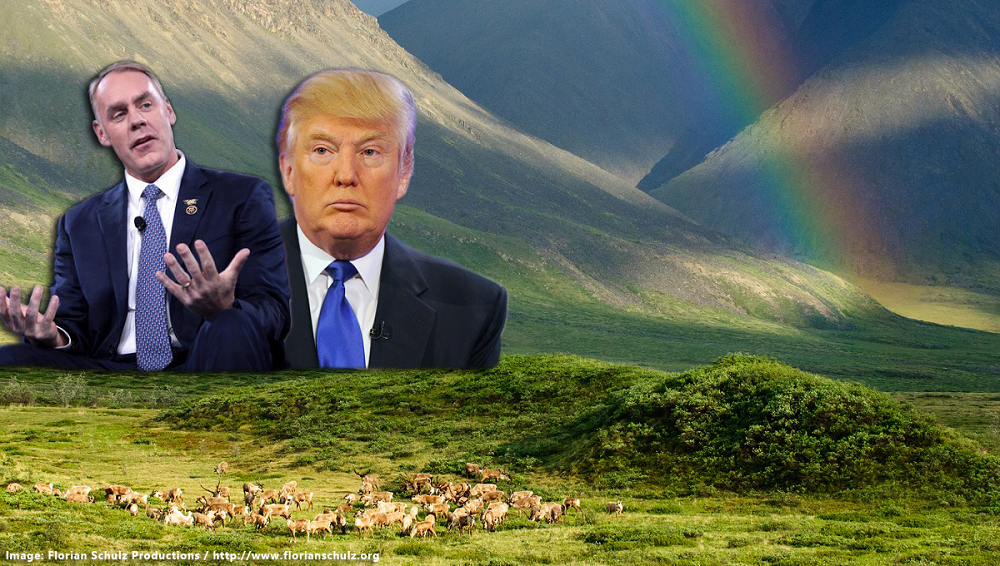Alaska Is Under Attack From The Trump Administration

Since Donald Trump’s inauguration and his nomination of Rep. Ryan Zinke (R-MT) to the position of Secretary of the Department of Interior, industry-fueled attacks on Alaska’s wild lands and waters have picked up.
These attacks reveal an unbridled hunger for drilling in America’s Arctic through targeted attempts to undo current protections. Places like the Arctic National Wildlife Refuge (Arctic Refuge), the National Petroleum Reserve-Alaska (Reserve) and the Arctic Ocean are not only under threat from climate change, but from politically motivated fossil fuel extraction that would damage wildlife habitat and compound climate impacts. Trump and Zinke have made it clear they want to line the pockets of the oil and gas industry by putting pristine Arctic landscapes on the table for destructive development.
Both Trump and Congress have the Arctic Refuge in their crosshairs
On September 15, a Washington Post piece revealed a leaked U.S. Department of the Interior (DOI) memo from August directing the U.S. Fish & Wildlife Service (USFWS) to update its rules to allow exploration in the Arctic Refuge. The update would effectively open up the Coastal Plain in the Arctic Refuge, the Refuge’s biological heart and a region that considered sacred by the native Gwich’in people, for seismic testing and exploration. Not only is this unprecedented move illegal under the Alaska National Interest Lands Conservation Act, but seismic blasting on the Coastal Plain would disrupt critical habitat for denning polar bears, migratory birds, the Porcupine Caribou Herd, and countless other species in this massive ecosystem.
A caribou in the Arctic National Wildlife Refuge. (Alaska Wilderness League)
The seismic push is just the latest attack on the Arctic Refuge. In May 2017, Secretary Zinke, while in Alaska, declared “Alaska is open for business” and issued a Secretarial Order that targets expanded drilling in the Arctic for future oil and gas development. The same month, the White House released its own budget proposal that includes $1.8 billion in speculative revenues from Arctic Refuge development. And both the Senate and House are on the path to fast track drilling in the Arctic National Wildlife Refuge by including it in their FY18 budgets.
Despite historic failures by industry, Arctic offshore drilling is back
Offshore in the Arctic, President Trump’s America First Offshore Energy Executive Order announced in April – commended by Secretary Zinke and industry alike – aims to open up America’s Offshore Continental Shelf for more drilling on every coast, including in the Arctic. Doing so would threaten the health, safety and economic prosperity of coastal and communities and ecosystems. The subsequent Request for Information released in July – the Trump administration’s first public comment period to override the previous administration’s oil and gas leasing plan – indicated a clear and deliberate intent to overhaul the years of work, thousands of public comments, and scientific consensus behind the Obama administration’s five-year plan unprecedented.
A polar bear leaps across the ice in the Beaufort Sea. (Florian Schulz / www.florianschulz.org)
Despite a 2015 DOI report that showed a 75% chance of a major oil spill (more than 1,000 barrels) if drilling were to occur in the Chukchi Sea, Trump and Zinke continue to chart a path toward development in the region. Climate change in the Arctic is happening twice as fast as anywhere else in the world, altering weather patterns, dramatically reducing sea ice, and driving more and more ocean-dependent wildlife – polar bears, walrus, etc., – to land. Add a drastic oil spill to the mix that could reach shore in days and takes months to reach by the Coast Guard, and you have a full-scale, ecosystem-wide disaster.
The Western Arctic, especially Teshekpuk Lake, is under threat
And in the Western Arctic, the National Petroleum Reserve-Alaska (Reserve) is the largest piece of federally managed land in the country. Around the size of Indiana, its nearly 23 million acres of nearly untouched wilderness is under threat from further leasing and drilling from the Trump administration and its dirty energy allies. Internationally valued and federally protected Special Areas within the Reserve including Teshekpuk Lake and the Colville River are specifically targeted because of their oil deposits. Birds from every state in the country migrate to Teshekpuk Lake, one of the most ecologically important wetlands in the Arctic.
A pair of musk ox in the National Petroleum Reserve-Alaska. (Dave Shreffler)
Despite the recognized biological significance of these areas, Secretary Zinke included the Reserve in his May announcement as a necessary area to “jump-start Alaska energy.” And the Bureau of Land Management’s recent call for nominations on lease sale tracts requested industry to include areas previously closed off to leasing under the Reserve’s 2013 Integrated Activity Plan (IAP). The Obama administration released the IAP after DOI spent years developing it, working hand in hand with the tribal community, local governments, the state of Alaska, the Western Arctic Caribou Working Group and others. Just as with the Arctic Ocean, Trump and Zinke are making it clear that their interests do not lie with the public or with science – their loyalties are with industry and industry alone.
Fossil fuels are not the future
More drilling in Alaska has never meant energy independence for the United States, let alone energy dominance. Exploring fragile Arctic ecosystems and harsh, unforgiving climates will not solve America’s energy problems. Alaska oil does not hold the answers to powering our future, and this decades-old industry push for development will only further delay a needed transition to clean, renewable energy.



